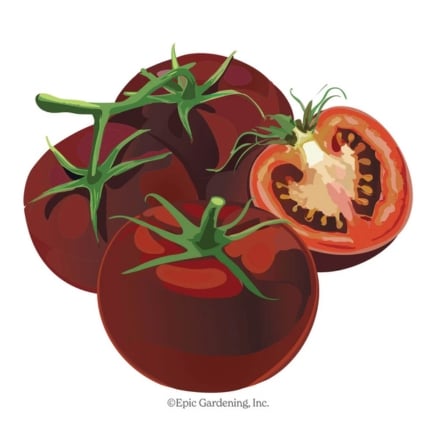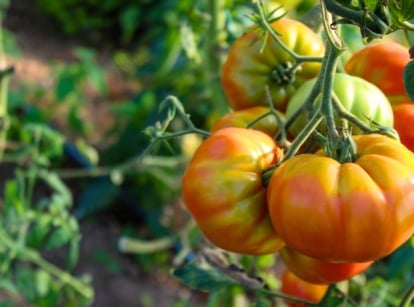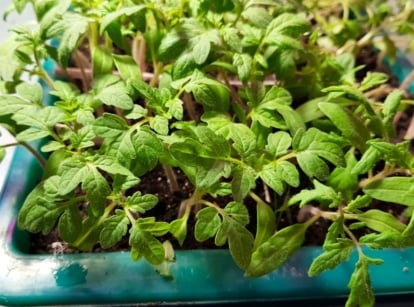13 Tomato Varieties to Start From Seed in April
There’s nothing like harvesting juicy, ripe tomatoes in the summer. To get an abundant summer crop, start some of your tomato seeds in April. In this article, horticulture expert Matt Dursum shows you the top tomato varieties to start planting before Easter.

Contents
Tomatoes are delicious, tropical vines that produce abundant fruits. In culinary terms, they’re treated as vegetables. They’re full of nutrients and antioxidants and have almost limitless uses. What’s even better is how easy they are to grow. By giving them enough water, well-drained soil, tons of direct sun, and nutrients, they’ll thrive in almost any garden.
Typically, you’ll want to start your tomato seeds indoors between 3 to 8 weeks before your last frost date. In most regions of the U.S., you can start between February and March. You can also sow your seeds outdoors in mild climates 1 to 2 weeks after your last frost.
However, some varieties grow quicker than others and fruit early in the season. You can start them in April for bountiful summer harvests. Below are 13 tomato varieties to start in April for delicious summer tomatoes.
‘Container’s Choice Red F1’

|
|
botanical name Solanum lycoperscium ‘Container’s Choice Red F1’ |
|---|---|
|
|
sun requirements Full sun |
|
|
height Up to 36” |
|
|
hardiness zones 3-11 |
‘Container’s Choice’ varieties take just 70 days to mature. If you start these tomatoes in April, you’ll be harvesting their plump red fruit in June.
These tomatoes are ideal for growing in containers like these. They like well-drained, loamy soil and full sun. Start them indoors in April and transplant them to larger containers once they’re a few inches tall. When the outside air temperature is above 45°F (7°C) and the soil temperature is 60°F (16°C), they’ll be ready for transplanting outdoors.
When these productive vines fruit, you’ll enjoy a bounty of large red tomatoes. They resemble beefsteak varieties and can weigh close to 8 ounces!
‘Italian Roma Bush’

|
|
botanical name Solanum lycoperscium ‘Italian Roma Bush’ |
|---|---|
|
|
sun requirements Full sun |
|
|
height Up to 36” |
|
|
hardiness zones 3-11 |
‘Italian Roma Bush’ varieties take roughly 80 days to ripen. If you start these determinate tomatoes indoors in April, you’ll have incredible harvests in July.
These summer treats produce deep-red oblong fruits. They’re perfect for stews, sauces, or drying in the sun. If you love making Italian tomato sauces or rich North Indian curries, start a succession of this bush variety in April. These varieties are also great for canning.
Sow them roughly a quarter-inch deep in well-drained soil. Transplant them when the air consistently rises above 45°F (7°C). If you live in an area with an extended growing season, start a second crop later in the season.
‘Sun Gold Pole Cherry’

|
|
botanical name Solanum lycoperscium ‘Sun Gold Pole Cherry’ |
|---|---|
|
|
sun requirements Full sun |
|
|
height Up to 6’ |
|
|
hardiness zones 3-11 |
If you’re looking for a cherry tomato variety to plant in April, try growing ‘Sun Gold’ pole tomatoes! One of our all-time Epic favorites, the plump and juicy fruits look like tiny golden tangerines. They burst with rich tomato flavor and balanced sweetness and acidity.
They only take 57 days to mature after transplanting. If you transplant them in late April, you’ll have your first harvests in mid-June. They’ll produce clusters of 8 to 14 fruits per stem.
As they mature, secure their vines with a trellis or a long pole. They’ll grow up to 6 feet long and need support. Plant them with shade-loving ground covers and leafy greens.
‘Red Pride Bush’

|
|
botanical name Solanum lycoperscium ‘Red Pride Bush’ |
|---|---|
|
|
sun requirements Full sun |
|
|
height Up to 36” |
|
|
hardiness zones 3-11 |
‘Red Prides’ are compact bush tomatoes. After transplanting, they produce fruits in around 78 days. Plant them in April to enjoy mid-summer harvests.
Healthy vines produce fruits up to 10 ounces. They’re perfect slicing tomatoes and make delicious chopped tomatoes for salsas and toppings.
These varieties are resistant to many diseases, including gray leaf spot, Alternaria stem canker, and Fusarium wilt. They’re excellent choices for growing in containers or as shrubs in your garden beds.
‘Sweetie Pole Cherry’

|
|
botanical name Solanum lycoperscium ‘Sweetie Pole Cherry’ |
|---|---|
|
|
sun requirements Full sun |
|
|
height Over 6’ |
|
|
hardiness zones 3-11 |
‘Sweetie Pole Cherries’ are rich, juicy, and well-balanced. They’re delectably sweet, with a classic tomato flavor that’s hard to resist.
These varieties ripen in just 65 days after transplanting. If you live in warm regions, plant them by seed indoors in April or directly sow them.
They’ll grow over 6 feet long on leggy vines. Support them on trellises or around garden walkways. They’ll grow quickly and give you tons of bright red fruit at the beginning of summer.
‘Carbon Pole’

|
|
botanical name Solanum lycoperscium ‘Carbon Pole’ |
|---|---|
|
|
sun requirements Full sun |
|
|
height 5-7’ |
|
|
hardiness zones 3-11 |
‘Carbon Pole’ is one of my favorite varieties, with huge, juicy fruits and large harvests. They take around 80 days to fruit after transplanting. Get them started in April, and you’ll have tons of massive fruits to harvest in mid-summer.
These tomatoes stood out at the 2005 Heirloom Garden Show, taking home the “Best Tasting Tomato” Award. They taste sweet, rich, and super complex. These dark red fruits will win over any foodie gardener with their umami-rich flavor and juiciness.
‘Carbon Poles’ are indeterminate tomatoes, meaning they’ll produce fruit throughout the growing season. The vines grow to over 7 feet long, so contain them on trellises or poles.
‘Glacier Bush’

|
|
botanical name Solanum lycoperscium ‘Glacier Bush’ |
|---|---|
|
|
sun requirements Full sun |
|
|
height Up to 30” |
|
|
hardiness zones 3-11 |
Glaciers are wonderful bush tomatoes to start in April. They take only 55 days to fruit after transplanting. Their low-growing habits make them compact and ideal for containers. They’re easy to care for and dependable for bountiful harvests.
They’ll start producing their delicious fruit in the early summer and last until fall. Each fruit is around 2 inches wide. They’re great for sandwiches or pizza toppings.
‘Tropical Sunset Pole Cherry’

|
|
botanical name Solanum lycoperscium ‘Tropical Sunset Pole Cherry’ |
|---|---|
|
|
sun requirements Full sun |
|
|
height Up to 6’ |
|
|
hardiness zones 3-11 |
‘Tropical Sunset Pole’ grows on long vines and matures in around 70 days. Plants produce clusters of sweet and slightly tart golden yellow fruits that are super juicy.
These cherry tomatoes are easy to maintain. Give them a long trellis or fence to grow on, and they’ll grow vigorously.
These fruits will last for several weeks after harvesting. They’re some of the sweetest cherry tomatoes you can grow. If you love making fresh garden salads, these varieties are a must.
‘Cherokee Purple Pole’

|
|
botanical name Solanum lycoperscium ‘Cherokee Purple Pole’ |
|---|---|
|
|
sun requirements Full sun |
|
|
height Up to 6’ |
|
|
hardiness zones 3-11 |
It’s hard to beat ‘Cherokee Purple’ in your garden. These award-winning tomatoes produce huge, juicy fruits with dark skins. They’re slightly smokey, packed with umami, and super sweet.
This variety takes 80 days to mature after transplanting. Plant in April and enjoy bountiful harvests by mid-summer.
They’re indeterminate and will continue producing fruit throughout the growing season until fall. Each fruit weighs 10 to 12 ounces. Use them for salads, stews, or soups.
‘Green Zebra Pole’

|
|
botanical name Solanum lycoperscium ‘Green Zebra Pole’ |
|---|---|
|
|
sun requirements Full sun |
|
|
height Over 6’ |
|
|
hardiness zones 3-11 |
‘Green Zebras’ are unique-looking tomatoes with greenish skin, forest-green stripes, and an amber blush. They’re intensely flavorful and surprisingly sweet. Another perk is their higher-than-average heat tolerance.
It takes roughly 75 days for these plants to bear fruit after transplanting. They’re indeterminate and need quite a lot of maintenance throughout their growing season. If you give them the care they need, they’ll grow to over 6 feet long and produce fruit until fall.
Support the long vines on trellises, cages, poles, or other creative methods of supporting your tomato plants. Grow them over shade-loving leafy greens or flowers.
‘Black Krim Pole’

|
|
botanical name Solanum lycoperscium ‘Black Krim Pole’ |
|---|---|
|
|
sun requirements Full sun |
|
|
height Over 6’ |
|
|
hardiness zones 3-11 |
‘Black Krim Pole’ tomatoes are absolutely mouth-watering. They come from the Russian Krymsk region on the Black Sea. Each fruit weighs between 10 and 12 ounces, with rich tomato flavor and tons of umami. They have reddish brown flesh and dark red skin.
These tomatoes mature 70 to 90 days after transplanting. If you start your seeds in April, you’ll have a bountiful harvest by late July to August.
Harvest them when they’re still partly green and firm. They’ll ripen off the vine and develop deep, dark hues and juicy flesh. These heirlooms are wonderful in hearty stews and sauces.
‘Mountain Merit Bush’

|
|
botanical name Solanum lycoperscium ‘Mountain Merit Bush’ |
|---|---|
|
|
sun requirements Full sun |
|
|
height 30-36” |
|
|
hardiness zones 3-11 |
‘Mountain Merits’ are classic bush tomatoes that are hard not to love. They take roughly 75 days to mature and fruit after transplanting. By mid-summer, you’ll enjoy a huge harvest from this determinate variety.
Each fruit is roughly 8 to 10 ounces and packed with rich umami and tomato flavors. It’s so delicious and easy to grow that it won the 2014 All America Selections Heartland awards.
Because of their bountiful harvests in mid-summer, these tomatoes are great for preserving. Use them for slicing and try canning the rest. Or, use them to make sauces throughout the season.
‘Golden Jubilee Pole’

|
|
botanical name Solanum lycoperscium ‘Golden Jubilee Pole’ |
|---|---|
|
|
sun requirements Full sun |
|
|
height Up to 6’ |
|
|
hardiness zones 3-11 |
‘Golden Jubilees’ are mildly flavorful and full of delicious juice. If you’re looking for perfect juicing varieties or salsa ingredients, these will be perfect. Each fruit comes out large and golden, with meaty flesh that’s great in salads and sandwiches.
These plants are indeterminate and take roughly 75 to 80 days to fruit. They’ll continue producing big, golden fruits through the summer and into the fall. They’re some of the highest-yielding varieties you can plant. Start them by seed in April and enjoy your first harvests by mid-summer.
Because of their quick, vine-like growth, you’ll need to support them as they grow. They’ll grow to over 6 feet if you maintain them.












